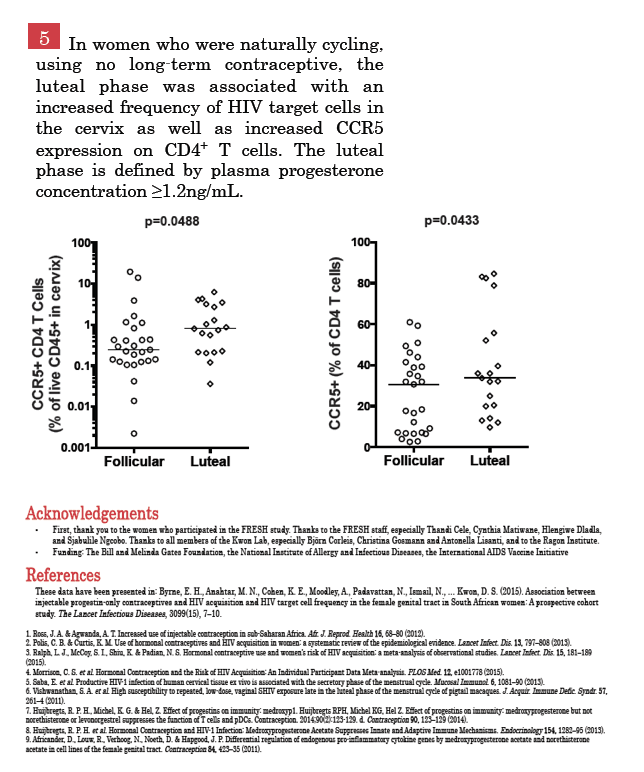 |
 |
 |
| |
The association of injectable progestin-only contraceptives and endogenous progestins with HIV target cell frequency in the cervix and HIV acquisition risk
|
| |
| |
Reported by Jules Levin
Durban 2016 July 18-22
Presenter
Douglas S Kwon
Authors
E.H. Byrne1, M.N. Anahtar1, K.E. Cohen1, A. Moodeley2, N. Padavattan3, N. Ismail3, B.A. Bowman1, G.S. Olson1, A. Mabhula4, A. Leslie4, T. Ndung'u1,3,4, B.D. Walker1,5,6, M.S. Ghebremichael1, K.L. Dong2, D.S. Kwon1,5
Institutions
1Ragon Institute of MGH, MIT and Harvard, Cambridge, United States, 2Females Rising through Education, Support and Health, Durban, South Africa, 3HIV Pathogenesis Programme, Durban, South Africa, 4KwaZulu Natal Research Institute for Tuberculosis and HIV, Durban, South Africa, 5Massachusetts General Hospital, Division of Infectious Diseases, Boston, United States, 6Howard Hughes Medical Institute, Chevy Chase, United States

Abstract
Background: Multiple observational studies have suggested that injectable progestin-only contraceptives (IPCs) are associated with HIV acquisition risk. However, the biological mechanism of this potential link was unclear. We aimed to understand immunological changes associated with exogenous and endogenous progestins that could mechanistically help explain a link to acquisition risk.
Methods: HIV-negative South African women ages 18-23 were enrolled in a prospective cohort study, the Females Rising through Education, Support and Health (FRESH) study. These women were at high risk of acquiring HIV, were living in Umlazi and were not pregnant. During the study, they were tested for HIV-1 two times per week; behavioral data along with blood and cervical samples were collected every three months.
Results: We characterized 423 HIV-uninfected women from the FRESH cohort. Of these, 152 women used IPCs, 222 used no long-term contraceptive and 43 used other forms of contraception. IPC users had a higher risk of acquiring HIV (12.06 per 100 person-years, 95% CI 6.41-20.63) compared to women using no long-term contraceptive (3.71 per 100 person-years, 1.36-8.07; adjusted hazard ratio 2.93, 95% CI 1.09-7.868, p=0.0326). In the cervix, CCR5+ CD4 T cells (HIV target cells) were 3.92 times more prevalent in IPC users than in women using no long-term contraceptive (p=0.0241). Of women using no long-term contraceptive, those in the luteal phase of the menstrual cycle had 3.25 times the frequency of cervical target cells compared with those in the follicular phase (p=0.0488).
Conclusions: High progestin levels, either due to the use of IPCs or the luteal phase of the menstrual cycle, are associated with an increased frequency of HIV target cells in the cervix compared to women with low progestin levels, in the follicular phase of the menstrual cycle. Because the female genital tract is the site of HIV entry in most women who become infected, the higher density of HIV target cells in a high-progestin state provides a potential biological mechanism for the epidemiological observation of increased HIV acquisition risk in IPC users.






|
| |
|
 |
 |
|
|